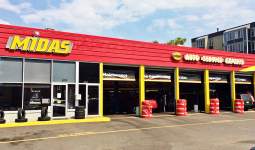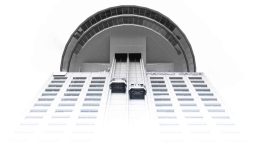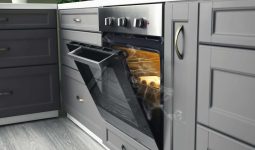The different types of rivets come in various sizes and materials, with certain standard sizes set by standardizing bodies such as ANSI and ISO.
Rivets are permanent mechanical fasteners used to attach big structural parts, tiny electronic assemblies, and just about any other type of item between these two.
Most rivets require access to both sides of a joint so that the unheaded side of the rivet may be mechanically deformed or damaged.
This is to provide a clamping action on the riveted joint once inserted. Blind rivets and drive rivets, which can be inserted entirely from one side of the joint, are exceptions.
Below are the different types of rivets.
1. Solid Rivets
Solid rivets are one of the strongest types of rivets, with their full-bodied design. They were used in structural steel structures and the like before bolted and welded-joint methods displaced them.
They come in cold and hot-headed variations and flat, cone, button, and countersunk head forms.
Four procedures are used to clinch the unheaded side: stake, spin-roller forming, orbital forming, and radial forming.
This includes staking being the quickest and cheapest approach but leaving the formed head largely unfinished.
Staking is frequently done by hand using a rivet gun and mandrel or bucking bar. The other three processes considerably increase the quality and strength of the completed head.
Solid rivets are available in various sizes and materials, including SAE 1010 and screw-machine steel, brass, nickel-silver, bronze, copper, stainless steel, and aluminum.
2. Self-piercing Rivet
SPR (self-pierce riveting) is a technique that uses a designed rivet to attach two or more materials.
Unlike other rivets, such as solid, blind, and semi-tubular rivets, self-pierce rivets do not require a drilled hole.
SPRs are semi-tubular in structure, with a partial opening at one end of the head.
The end shape of the rivets features a chamfered poke that helps the rivet penetrate the materials being bonded.
The rivet is driven into the material by a hydraulic or electric servo rivet setter, and an upsetting die produces a cavity for the displaced bottom sheet material to flow through.
The self-pierce rivet penetrates the top sheet material(s) entirely but only partially through the bottom sheet.
The joint is water or gastight since the rivet tails do not penetrate the bottom sheet.
Under the impact of the upsetting die, the rivet tail widens and interlocks with the bottom sheet, generating a low-profile button.
3. Blind Rivet
Blind rivets, sometimes known as POP rivets, are fasteners that allow materials to bond when the backside of the joint (i.e., the blind side) is restricted or has no access.
Unlike other rivets, which require access to both sides of a joint to connect materials, blind rivets require access to one side to fasten materials together.
A tubular structure with a mandrel passing through the center characterizes the traditional blind rivet design.
To use this type of blind rivet, a pre-drilled hole through the materials being secured must be drilled, into which the blind end of the rivet is inserted.
After inserting the blind rivet, a skilled riveter pulls the mandrel back, causing the inserted end to expand, which fastens the materials together and produces the joint.
4. Threaded Rivet
The threaded-stem rivet features an internally threaded mandrel (stem) and an exterior part cut flat on two sides to allow the tool to grasp and spin it.
The head is usually hexagonal to prevent the tubular body from spinning, while the mandrel is torqued and broken off.
Threaded inserts and rivet nuts create a strong permanent thread through sheet material and other materials when installation is only feasible from one side.
These rivets have a threaded internal mandrel stem with a machined flat outer edge on two sides for holding and rotating the tool.
The head is generally hexagonal to prevent the tubular body from spinning while the mandrel is twisted and disassembled.
5. Flush Rivet
Flush rivets are commonly used on external metal surfaces when a clean appearance and removal of unwanted aerodynamic drag are sought.
A flush rivet uses a countersunk hole, also known as a countersunk rivet. Countersunk or flush rivets are commonly used outside airplanes for aerodynamic reasons such as decreased drag and turbulence.
Further post-installation machining might be undertaken to increase airflow. Furthermore, flush rivets use countersunk rivets; consequently, flush rivets are also known as countersunk rivets. These different types of rivets are mostly used on the exterior of airplanes for aerodynamic reasons.
6. Split Rivets
Split rivets, or bifurcated rivets, are self-piercing rivets that link softer materials like fabrics, leather, plastic, or wood.
These rivets are pre-split down the length of their shaft, producing two “legs”; when installed, the legs of a split rivet fold back to hold the attached materials together.
Split rivets are often used to manufacture leather products, apparel, fabric, and soft-sided carrying bags.
Split rivets penetrate soft materials like wood, leather, and plastics. These are typical “home repair” rivets.
They have seen or split bodies with sharp edges to pierce leather, fiber, plastic, or soft metals. They are not used in high-stress situations.
The design resembles a saw or split body, with pointed ends that drill holes in leather, fiber plastic, or soft metals. Split rivets are rarely used in rising situations.
7. Oscar Rivet
Oscar rivets perform similarly to blind rivets, but a hollow shaft separates them. The splits force the shaft to rotate in and out when the mandrel is pushed into the rivet.
This flare offers a greater bearing surface, reducing the possibility of rivet wear out. These designs are suited for high-vibration situations when access to the back surface is restricted.
In any event, Oscar rivets have a blind look with a split and a hollow shaft. The splits force the shaft to bend in and out as the mandrel is pushed into the rivet.
This flare increases the bearing surface, lowering the chance of rivet wear out. These designs are suited for high-vibration situations with inaccessible back surfaces.
8. Friction Lock Rivet
Friction Lock Rivets are one of the best different types of rivets. These are similar to expanding bolts, except the shaft breaks below the surface when the tension is high enough.
Blind ends can be countersunk (‘flush’) or dome-shaped. Cherry friction-lock rivets were an early type of blind rivets used in aircraft construction and repair.
Originally, cherry friction locks were available in hollow shank pull-through and self-plugging.
Although the pull-through rivet is no longer utilized, the self-plugging Cherry friction-lock rivet is still used for light aircraft repairs. Friction-lock rivets cannot be used in place of solid shank rivets.
When replacing a solid shank rivet with a friction-lock rivet, the friction-lock rivet must be at least one size bigger in diameter.
The friction-lock rivet loses substantial strength if its center stem slips out due to vibrations or damage.
9. Drive Rivet
Drive rivets are blind rivets with a little protruding mandrel from the head.
Following the insertion of the drive rivets into the hole, the mandrel is pushed with a hammer or other instrument to pry the rivet end into the hole.
Since the holes do not need to be drilled through the panels, they are usually used to rivet wood panels in place, resulting in an aesthetically attractive look.
They may also be used with plastics, metals, and other materials. They may require no additional setting equipment besides a hammer and a backing block behind the riveting site.
Drive rivets have a lower gripping force than normal rivets. Drive screws, also known as drive rivets, are frequently used to fasten the nameplate in the blind hole.
10. Semi Tubular Rivet
Semi-tubular rivets are identical to solid rivets, except they feature a hole opposite the head at the end of the rivet.
When force is applied to this hole, the tubular part of the rivet around the hole rolls outward. These rivets need less effort to apply and assemble.
The forces necessary to apply a semi-tubular rivet are roughly one-fourth (1/4 ) of those required to attach a solid rivet.
Since the rivet only expands at the tail, tubular rivets are sometimes selected for pivot points.
Semi-tubular rivets are accomplished utilizing several methods, from prototype tools to fully automated systems.
Semi-tubular rivets are easier to apply and install. Handset, Manual Squeezer, Pneumatic Squeezer, Kick Press, Impact Writer, and PLC-driven robots are the installation tools for these.
Semi-tubular rivets are popular in brakes, ladders, binders, HVAC ductwork, and other applications.








